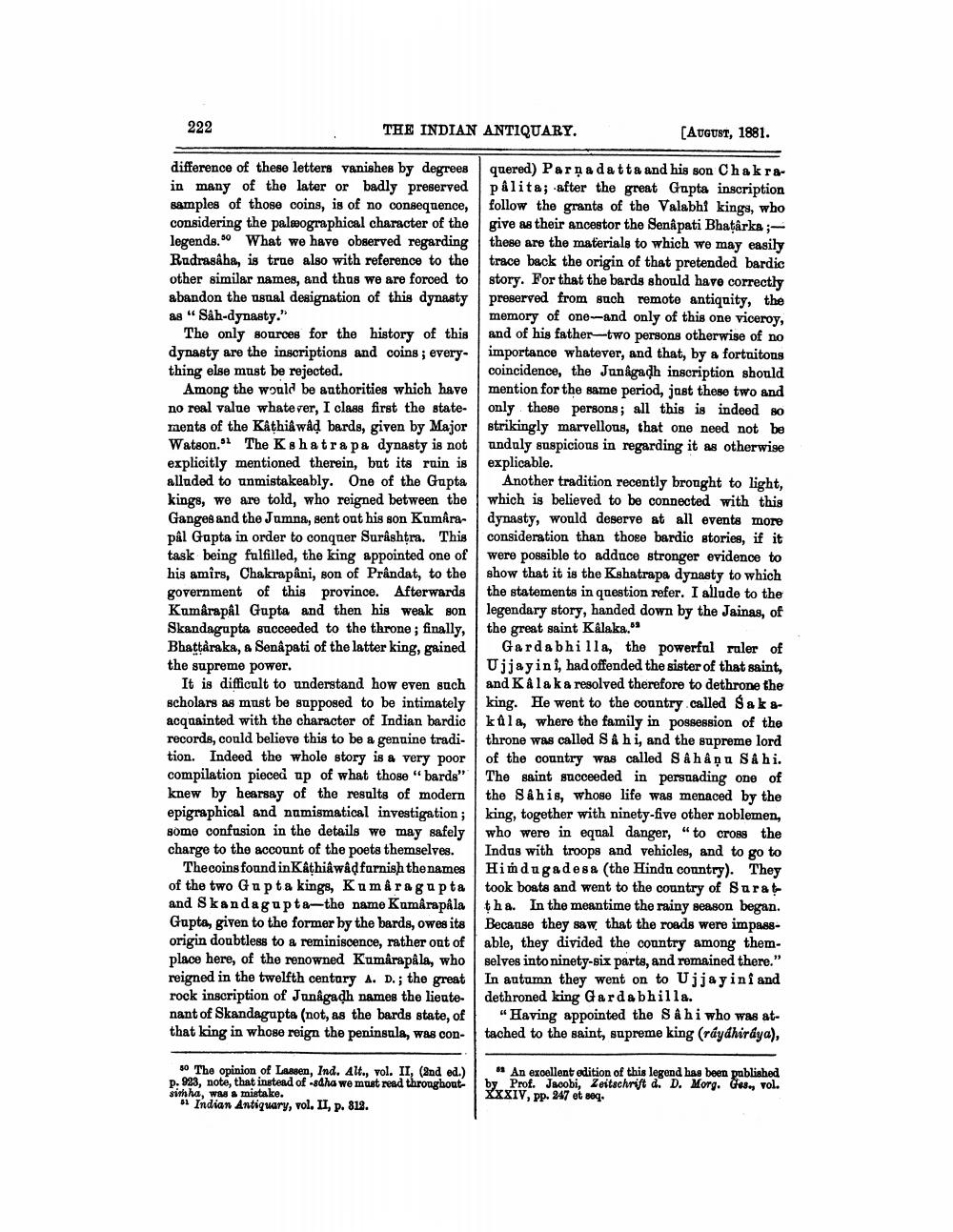________________
222
THE INDIAN ANTIQUARY.
[AUGUST, 1881.
difference of these letters vanishes by degrees quered) Parņadatta and his son Chakrain many of the later or badly preserved pålita; after the great Gupta inscription samples of those coins, is of no consequence, follow the grants of the Valabhi kings, who considering the paleographical character of the give as their ancestor the Senapati Bhatarka ; legends. What we have observed regarding these are the materials to which we may easily Rudraskha, is true also with reference to the trace back the origin of that pretended bardic other similar names, and thus we are forced to story. For that the bards should have correctly abandon the usual designation of this dynasty preserved from such remote antiquity, the as “Sah-dynasty."
memory of one--and only of this one viceroy, The only sources for the history of this and of his father-two persons otherwise of no dynasty are the inscriptions and coins; every- importance whatever, and that, by a fortuitous thing else must be rejected.
coincidence, the Junagadh inscription should Among the would be authorities which have mention for the same period, just these two and no real value whatever, I class first the state- only these persons; all this is indeed so ments of the Kathikwad bards, given by Major strikingly marvellous, that one need not be Watson. The Kshatra pa dynasty is not unduly suspicious in regarding it as otherwise explicitly mentioned therein, but its ruin is explicable. alluded to unmistakeably. One of the Gupta Another tradition recently brought to light, kings, we are told, who reigned between the which is believed to be connected with this Ganges and the Jumna, sent out his son Kumara- dynasty, would deserve at all events more pål Gupta in order to conquer Surâshtra. This consideration than those bardic stories, if it task being fulfilled, the king appointed one of were possible to adduce stronger evidence to his amirs, Chakrapani, son of Prândat, to the show that it is the Kshatrapa dynasty to which government of this province. Afterwards the statements in question refer. I allude to the Kumärapål Gupta and then his weak son legendary story, handed down by the Jainas, of Skandagupta succeeded to the throne ; finally, the great saint Kalaka." Bhattåraka, & Senâpati of the latter king, gained Garda bhilla, the powerful ruler of the supreme power.
Ujjayini, had offended the sister of that saint, It is difficult to understand how even such and Kalaka resolved therefore to dethrone the scholars as must be supposed to be intimately king. He went to the country called Saksacquainted with the character of Indian bardio kala, where the family in possession of the records, could believe this to be a genuine tradi- throne was called Så hi, and the supreme lord tion. Indeed the whole story is a very poor of the country was called Sahâņu Sahi. compilation pieced ap of what those "bards" The saint succeeded in persuading one of knew by hearsay of the results of modern the S&his, whose life was menaced by the epigraphical and numismatical investigation; king, together with ninety-five other noblemen, some confusion in the details we may safely who were in eqnal danger," to cross the charge to the account of the poets themselves. Indus with troops and vehicles, and to go to
Thecoins found in Kathiâwâdfarnish the names Hindugadesa (the Hindu country). They of the two Gupta kings, Kumiragupta took boats and went to the country of Surat and Skandagupta-the name Kumarapala tha. In the meantime the rainy season began. Gupta, given to the former by the bards, owes its Because they saw that the roads were impassorigin doubtless to a reminiscence, rather out of able, they divided the country among themplace here, of the renowned Kumarapala, who selves into ninety-six parts, and remained there." reigned in the twelfth century A. D.; the great In autumn they went on to Ujjayini and rock inscription of Junagadh names the lieute- dethroned king Garda bhilla. nant of Skandagupta (not, as the bards state, of 1 "Having appointed the Sahi who was atthat king in whose reign the peninsula, was con- tached to the saint, supreme king (ráydhiraya),
40 The opinion of Lassen, Ind. Alt., vol. II, (2nd ed.) p. 933, notē, that instead of sdha we must read throughout simha, was a mistake.
51 Indian Antiquary, vol. II, p. 812.
An excellent edition of this legend has been published by Prof. Jacobi, Zeitschrift d. D. Morg. Ges., vol. XXXIV, pp. 247 et seq.




